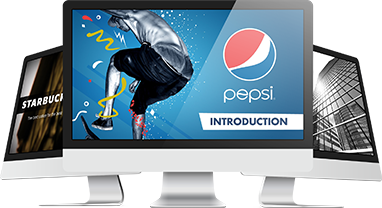Sales and marketing have a unique relationship.
It’s marketing’s job to create opportunities for sales. In turn, the sales team works with the marketing team to continually hone and refine the messaging.
When this partnership is firing on all cylinders, the company grows, but alas, there’s a gap in the process.
If Sales Guy Steve doesn’t tell Marketing Maggie what he needs to sell better, how could she provide him with the right sales pitch?
Likewise, if Maggie doesn’t know Steve’s prospect audience, the pitch deck he’s getting won’t help him illustrate value.
Marketing and sales need to be on the same page.
Channeling core marketing principles into sales pitches is the best way to bridge any gaps.
Define Strategy Before Deploying Tactics
What do you want the results of the sales pitch to be?
Having a goal is an important first step in creating effective sales pitch decks.
This is where sales needs to collaborate with marketing and say, with certainty, what the final objective is.
Is it to:
- Capture prospect interest?
- Introduce or emphasize benefits?
- Create an immediate sale?
- Take market share from a competitor?
The biggest misconception is that sales is always about making an immediate sale.
It’s not. It’s about building customer confidence.
Sometimes the sale might come right away; other times, the pitch is just a stepping stone on the way to a future sale.
No matter the audience, have a goal. Know the goal. Design with the goal in mind.
Strengthen Your Message by Knowing Your Audience

Before a sales pitch is given, you need to know who you’re talking to.
As simple of a concept as it is, however, it’s often overlooked in the rush to illustrate benefits.
Benefits are universal; how they’re presented depends on the audience. Presenting benefits without the right spin tends to come off as generic or vague.
Consider these two examples for the same product:
Generic: Product X lasts 2x longer than the competition and costs half the price!
Targeted: Single moms on a budget trust Product X because it lasts 2x longer than the competition. At half the price, it’s easier than clipping coupons.
The benefits are the same in both examples, but the latter is more powerful. The targeted example speaks to someone, not at them. It shows the concerns of single moms—shopping on a budget and saving time. It shows this core consumer group that you see them and understand what’s important to them.
Once you have their attention, make sure you hold on to it.
Make a Connection (and Move the Needle) with a Story
Once you know who you’re talking to and have their attention, give prospects a reason to act.
Inspire them. Evoke emotion. Get them fired up!
The simplest way to tap into feelings and action is to craft a narrative. Simply put: Tell them a story.
Let’s face it: People don’t like being sold to. They prefer to make decisions on their terms, which means relying on your sales pitch to do the selling for you.
Pitch Decks that tell a story are more likely to get a favorable response than a classic sales pitch.
Consider the following example:
You worked 60 hours this week. You’ll work 60 hours next week. But today’s Saturday and you’re not working today. Today is all about sweatpants and slippers, comfort food and naps. Today is your day. What better way to make the most of it than with Product X?
Even that small snippet is a story.
A story is something people can relate to, that evokes emotion and creates understanding.
It’s the modern way of selling, and it’s only possible when sales and marketing work together.
Use storyboarding to identify the right narrative for your target customer. Then, support your pitch with powerful copywriting and design to drive home the sale.
Increase Interest by Keeping Engagement High

Engagement.
One of the most important objectives for any marketing campaign is just as important when it comes to sales pitches.
This is where beautiful and thoughtful design comes in and can really take sales pitch decks up a notch.
All of the following are powerful stimuli that keep prospects attentive and engaged in your messaging:
- High-quality imagery, animations, and effects
- Branded slides (fonts, colors, logos)
- Telling a story (more on this in the next section)
Giving prospects something to look at beyond text is important.
Remember, sales pitches have to be stimulating to generate interest in the sale itself.
If the message (and how it’s delivered) is uninspiring, prospects won’t pay attention.
Keep It Simple, Especially with Data Visualization
A marketing pitch needs to be as simple as possible. It should stay focused on a specific topic and remain straightforward from start to finish.
Just like brand experiences need to be cohesive and consistent, slides in a deck should be as well.
It all comes back to the KISS philosophy.
As a good rule of thumb, every slide of a sales pitch deck should present a singular idea. That idea should be succinctly summarized and supported with engaging text and images.
This is especially important when it comes to data visualization.
Someone should be able to process what’s in front of them in about a minute or two. The simpler things are, the more likely the idea will land.
It’s the job of sales to tell marketing what these most important features are. Then, it’s the job of marketing to convey them concisely.
Differentiate Your Message
Too often, sales will hand over competitor marketing materials to the marketing department and say “I want it to look like that.”
As a result, your sales pitch and deck won’t look any different to your customer.
Worse still, it might look like a rip-off if they’ve already been pitched by a rival.
Don’t focus on designing a pitch deck that disputes your competition. Instead, focus on designing one that distinctly differentiates your brand and its products or services.
This is the foundation of a successful sales pitch.
A novel idea is going to get much more traction than a rehash of something your prospect has seen and heard before.
Fall back on your branding. Make sure the benefits speak clearly to the audience. Keep prospects engaged. The success of your pitch hinges on how appealing you make your message—and there’s nothing more appealing than something new.
Deliver a Compelling Call-to-Action

When the pitch wraps up, what do you want people to do?
What’s the most important takeaway for them?
Ending on a blank slide with the company logo immediately invalidates your efforts. Instead, end with a call-to-action:
- Contact a sales rep
- Visit this website
- Place your order
- Call this number
Giving explicit instructions leaves no room for error in helping prospects act.
It’s the final step in an effective sales pitch—arguably the most important step.
A well-crafted sales pitch deck helps Sales Guy Steve sell better. But to get one into his hands and in front of prospects, Marketing Maggie needs to understand his needs.
When sales and marketing collaborate, it’s evident. Sales pitch decks not only look great, they speak volumes to the people they’re made for.
Ready to take your pitch deck to the next level? Schedule a free pitch deck consultation now.





























